Breakpoints and Drawing Lines on the Lane
( Part 2 )
by Ron Clifton
When I say breakpoint, I am NOT talking about the moment
you left just one too many 10-pins and decided to throw all your balls in the river. I
am talking about a spot down the lane where the ball starts to hook toward the
head pin. If you followed last month's coaching tip on how to find your breakpoint, you are ready to learn how to use it. Keep in mind that this tip is
mostly for bowlers that hook the ball.
First of all, as with everything in bowling, there is
no one system that works for everyone on every lane condition; but you will find
that on most lane conditions, your best carry percentage will place your
breakpoint between the 5 and 8-boards, 40 feet or so down the lane. This will
give you a good angle of attack on the pocket for your best carry percentage.
This also puts the ball outside the river of oil that runs down most house oil
patterns between the two 10-boards. Itís very important to have your
breakpoint outside that deep oil. A lot of the 10-pins I see left in league come
from the bowler not getting the ball outside the 9-board at the breakpoint. The
ball looks great to the bowler. He hit his mark and threw the ball well, but
there stands the 10-pin. This happened because the ball hit the 9,10, or 11-board
at the breakpoint and never had a chance to grip the lane well enough or have
enough angle to carry. Most bowlers do not notice where their ball is at
the breakpoint, so they just feel like they got robbed.
Now that we have
learned to watch our ball at the breakpoint, how do we use it in a targeting
system? First of all, decide what part of the lane you are going to play around
the arrows. This will be dictated by the oil pattern on the lane and how much it
is hooking, but letís say we want to cross the lane at the 3rd
arrow.
Walk up to the foul line and look at the 7-board down the
lane where your breakpoint lies. Then draw an imaginary line from that 7-board
back through the 3rd arrow to your bowling shoulder. We now have a
line to throw the ball down. You can target with your eyes anywhere along that
line, but for most people itís easier to just look at the 3rd arrow.
We need to make sure that when we deliver the ball we are facing our breakpoint
so the ball will travel along our imaginary line. Because our balls go straight
once we release them until they get to the breakpoint, we donít have to try
and make the ball follow our line, it just will. The idea of course, is to throw
the ball, crossing the 3rd arrow and continuing to the 7-board at the
breakpoint before hooking to the pocket. Now donít expect to actually nail the 7-board at the breakpoint every time. How accurate you are at the breakpoint will
depend on the level of your game. The best pros on tour can hit a breakpoint
about 2-boards wide, while the best amateurs will be closer to 3-boards wide.
The goal for a good league bowler should be about 4-boards.
|
Here Jimmy Martin lines up to throw the ball from around
the 4th arrow to a breakpoint of 7, 42 feet down the lane. The red line
shows the actual path he wants the ball to follow. The blue line is drawn
from the breakpoint to where he is actually standing. Jimmy knows he is
going to drift left as he makes his approach, so he takes that into
account. |
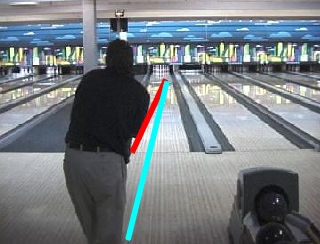
|
|
When you are first learning to draw a line to your
breakpoint, you may need to walk up the the foul line a see where you need
to end your approach. Get into your finishing position as if you were just
releasing the ball and notice the direction you need to be facing and what
board you wish to slide on to follow the red line. |
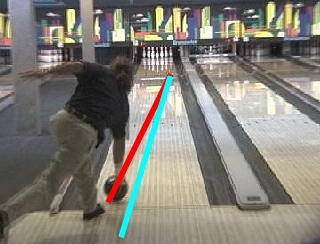
|
|
I placed 2 pieces of tape on the lane, 41.5 feet down the
lane: one on the 5-board and one on the 9-board. The idea is to go
between them. Jimmy is a good enough player he can throw between
them, hit them or go around the outside one if I tell him to. |
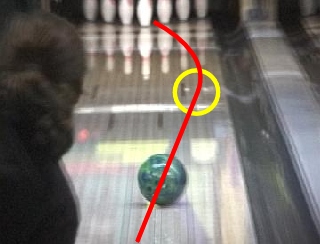
|
|
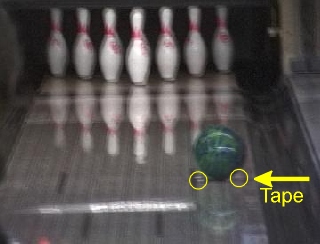
|
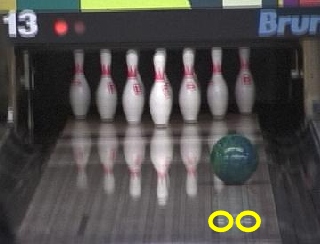
|
|
Notice the ball goes straight for about 4 feet before it
turns left to head for the pocket. The breakpoint is not a single point
on the lane, but we treat it as such for lining up. |
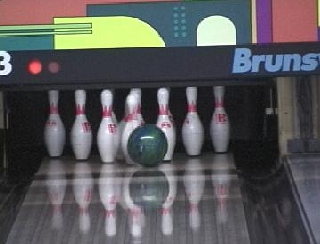
|
One
of the most important things about having a line to throw down is to know when
we really didnít throw a good shot, even if the ball still went into the pocket.
On the first day of geometry class, they told you it takes two points to
make a line. Using just the 3rd arrow as the only target is not good
enough because that is a single point on the lane. You can cross that point in
any direction. That means you could hit the 3rd arrow, but only make
it to the 10-board at the breakpoint instead of in the area of the 7-board. On a
league shot, that ball may still go into the pocket; heck it may even strike, but
often it will be a 9-count. On a flatter oil pattern like they use on the pro
tour or at one of the megabucks tournaments, the shot will go through the
nose or even cross over. Knowing and watching your breakpoint can keep you
honest, even on the easiest of lane conditions. If you are paying attention, you
will know if you made a good shot or if the lane man got the strike for you.
This
is how we use our breakpoint as part of a targeting system. So when you hear me
say ďare you hitting both targetsĒ, you will know what I mean. You will have to
make adjustments depending on the lane condition and know what to do if you make
your breakpoint and the ball fails to go to the pocket.
Using the breakpoint, we can shorten the lane to about 20 feet. That's because
we only have to worry about what the ball does between the breakpoint and the
pocket. We need to pay very close attention to the ball and how it is rolling
the last 20 feet of the lane. I will discuss that next month in Part 3 of ďBreakpoints
and Drawing Lines on the LaneĒ.
Bowl great!
Ron Clifton
I can be contacted through email at rclifton@triad.rr.com




